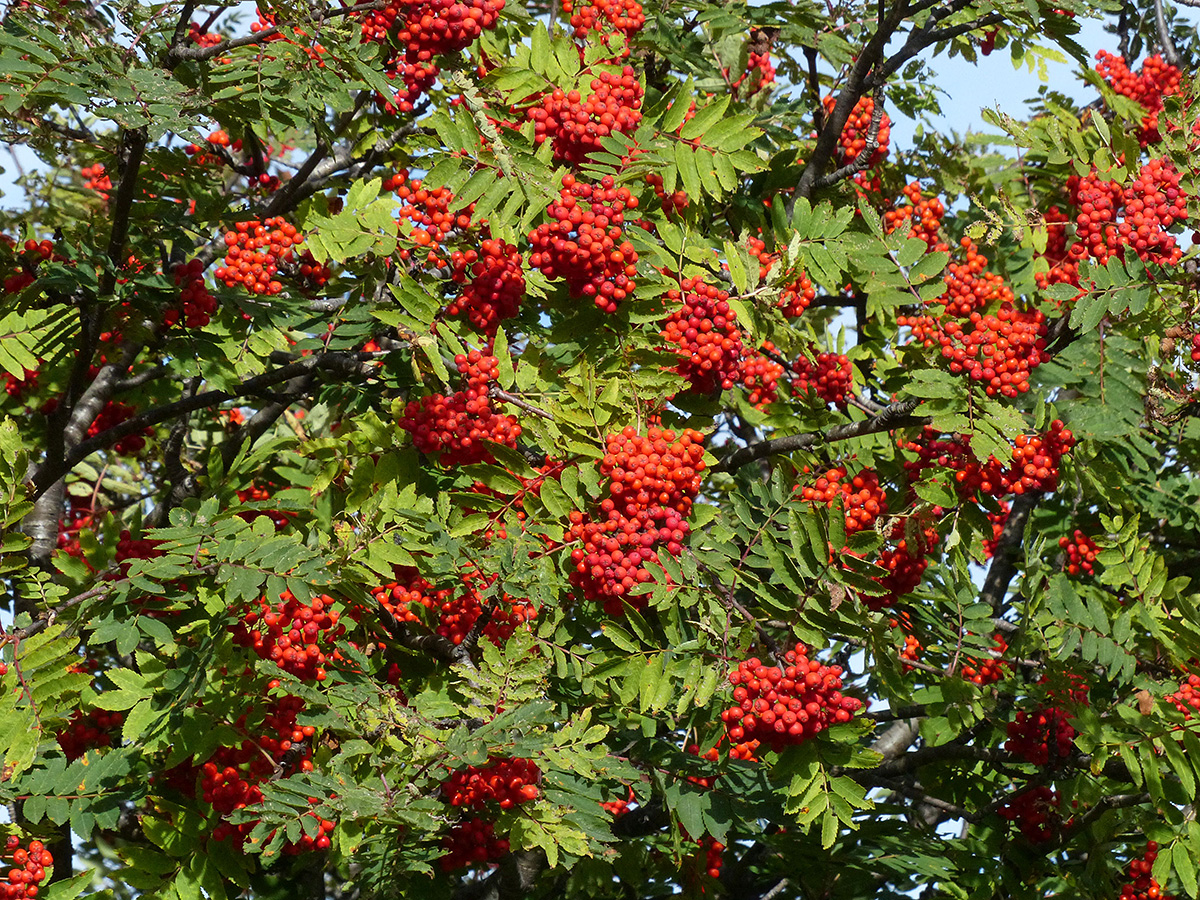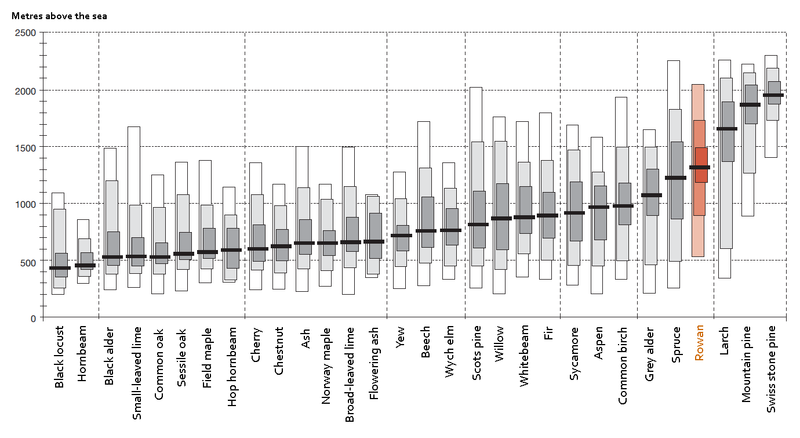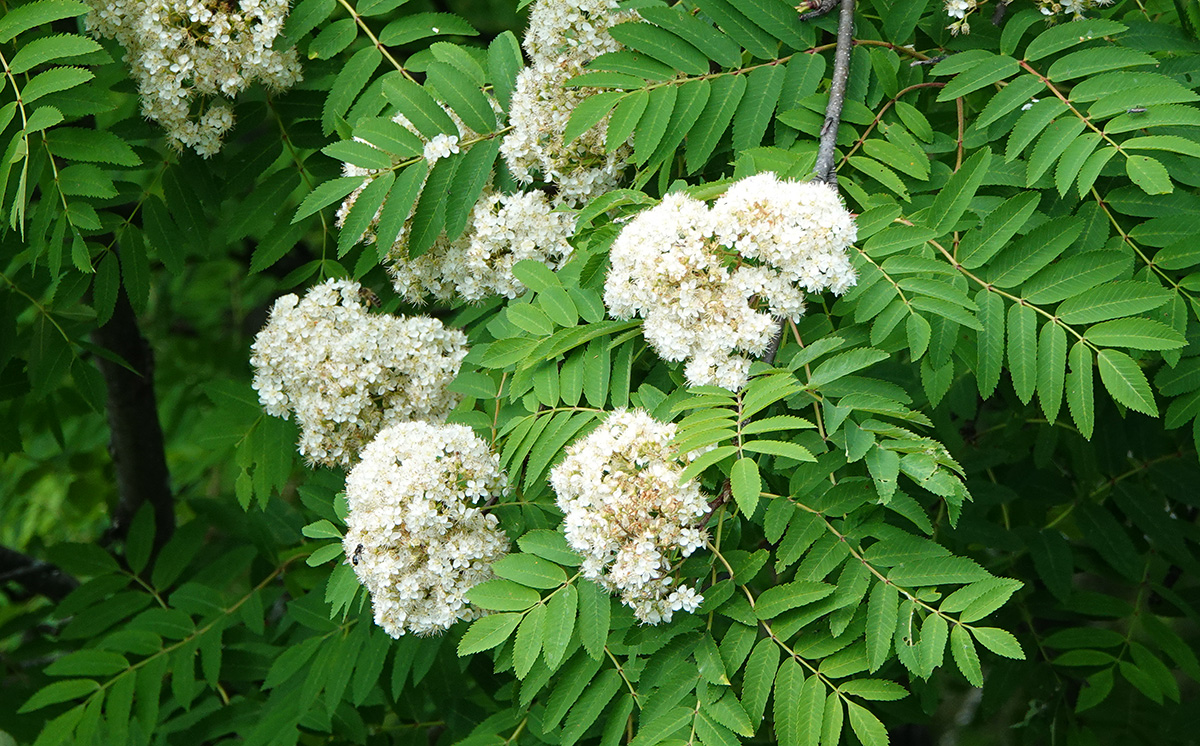Geographical distribution
The rowan or mountain ash (Sorbus aucuparia) is found throughout virtually all of Europe – a vast area, spanning from deep Siberia to the northern forest line in Scandinavia.
This wide distribution, including in terms of altitude, is due to its extraordinarily high tolerance to different sites. According to Leibundgut (1984), marshes, black alder stands and virgin soils are the only places this often shrub-like tree species does not appear.
The rowan is found throughout Switzerland, and this is reflected in the variety of Swiss German names for the tree.
Table 1: Names for the rowan tree used in Switzerland (Brändli 1996, Bosshard 1978)
| German | Vogelbeere, Vogelbeerbaum, Eberesche |
| Swiss German | Vogelbeeri, Vogeleschli, Eberesche, Äbarescha, Schwiiesche, Stinkösche, Wielesche, Wüelesche, Wildesche, Welesche, Wielerche, Büelesche, Nielesche, Gürmsch, Girmsch, Gürgetsch, Göretsch, Gürratsch, Girigitsch, Girrätsch, Gürütsch, Bärwid, Eschvogelbeerbom, Gaisseleiterli, Güggelhödis, Lischme, Mooseisch, Moosesch, Wiissmehlbomm |
| Romansh | culaischen, culeschem |
| ltalian | sorbo degli uccellatori, tamarindo, sorbo selvatico |
| French | sorbier des oiseleurs |
However, in the areas of the Jura and Swiss Plateau that see little precipitation, the rowan is rare and locally absent, around Basel, for instance, or at low altitudes on the western Swiss Plateau (Figure 2). The tree is primarily distributed in the western and central areas of the northern outer Alps and the Jura as well as in Lower Valais. The western Alps are home to the largest proportion (1.8%) of thicker rowans (BHD ≥ 12 cm) (Figure 3).
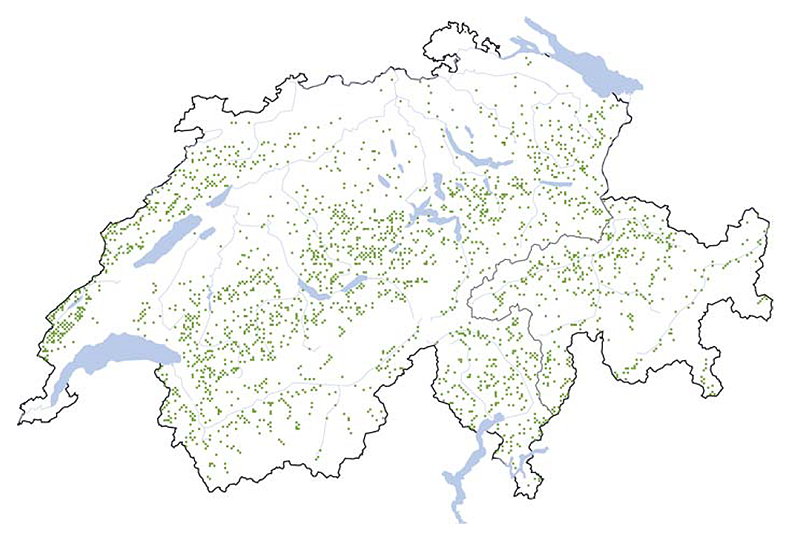
Figure 2 - Distribution of rowans on NFI sample plots
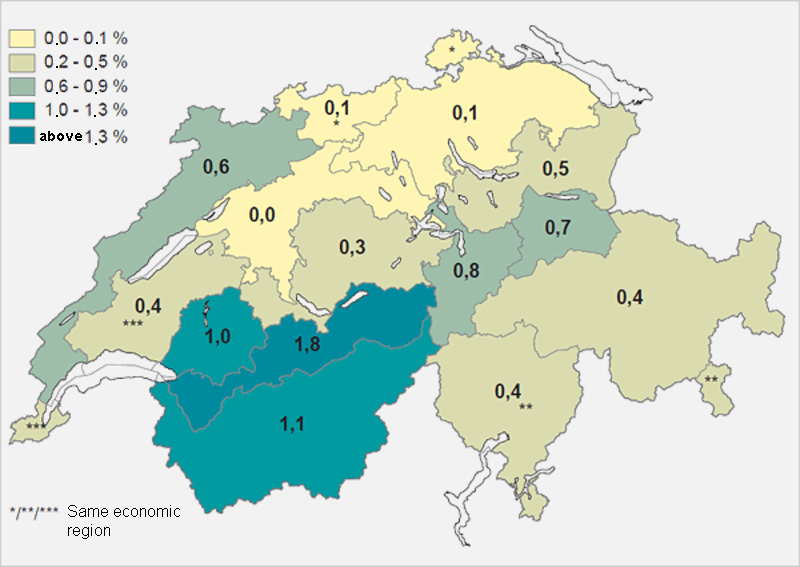
Figure 3 - Proportion of rowans by economic region (as a % of all trees with a BHD ≥ 12 cm) as per NFI4 2009/17
Site specifications
90% of rowan trees grow in the upper montane and lower subalpine zones, with half of these lying more than 1,300 metres above the sea (Figure 4). The NFI rowan sample plot at the highest altitude is currently located 2,167 metres above the sea at Saas-Balen, Valais. When combined with the alpine alder (green alder), the rowan can be found at altitudes of up to 2,300 metres. It is the deciduous tree with the greatest altitudinal distribution, just ahead of the birch and grey alder (Figure 4). The occurrence of this photophilous pioneer species is largely conditioned by competition. It is more common than average in sparsely populated mountain forests, in selection-type, non-uniform high forests, in young growth, and in uniform high forests with clearings.
The rowan usually thrives on slopes (lateral light) at inclines of 10° or more. At lower altitudes, it prefers the cool, wet climate of the north-western to north-eastern slopes, in contrast to the whitebeam. Like the spruce, the rowan favours acid subsoils but can also be found in alkaline soils. It appears in combinations in numerous forest communities and dominates only in the very rare green alder/rowan forests. More than any other deciduous tree species, the rowan is mainly distributed in coniferous forests. Two thirds of rowans populate spruce stands; the rest are found in fir, larch, beech and maple forests.
Frequency
With a population of 2.7 million trees (BHD ≥ 12 cm) and a proportion of 0.5%, the rowan appears rather insignificant. However, if plants 10 cm or taller are taken into account, the tree is found on 31% of NFI plots. This widespread tree species is short-lived, typically living 80 to 100 years, but no more than 150 years. Rowans taller than 15 to 20 metres (NFI1: max. 24 metres) or wider than 25 to 30 cm (NFI1: max. 37 cm) are rare.
Game browsing is often highlighted as a threat to a sustainable population. According to the NFI, previous year browsing affecting rowans 10 to 129 cm tall has fallen from 44% to 35% throughout Switzerland over the past two decades. At the same time, despite the considerable damage caused by browsing, the number of young rowan trees in this height class has increased significantly, as has the number of rowans in secured regeneration (classes BHD 0.1 to 3.9 cm and BHD 4.0 to 7.9 cm) throughout Switzerland. However, these predominantly positive average values should not hide the fact that browsing damage is often substantially higher at local level and the population may be at risk.
Significance
According to the fourth NFI 2009/2017, the rowan has a stock share of 0.08% and an average stem volume of 0.1 m3, making it a typical secondary tree species with little value for the timber industry, similarly to the whitebeam, field maple, bird cherry and grey alder, for instance. After rapid juvenile growth, the increment decreases after 20 years.
The timber is only of economic importance in northern Eurasia as wood for furniture, for example. Thin trunks make good walking sticks and tool handles, while thicker specimens are valued by wood turners and carvers. This soft wood was previously also used for gears, dowels and axles. Today it is sold as firewood at best.
In silviculture, the rowan plays an important role as a natural pioneer species in the regeneration of subalpine spruce forests or in the natural succession of tall forb/fir forests. It is resistant to frost and snow load and, as a pioneer species, provides the necessary protection for climax forest species with regard to windthrow or clearings. Being very elastic when young and able to reproduce through seed formation as well as basal sprouting, offshoots and stump sprouts (Figure 6), in the subalpine zone the rowan is essential to the afforestation of rock avalanches and as a protective forest species in biological barriers against torrent and avalanches.
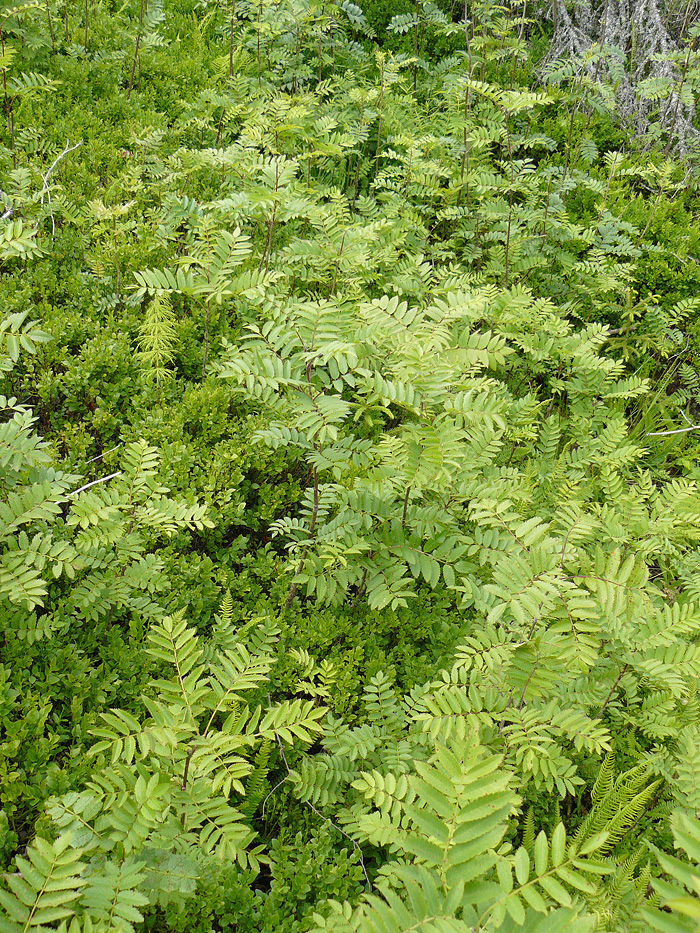
Figure 6 - The rowan can reproduce through seed formation as well as basal sprouting, offshoots and stump sprouts. Photo: Thomas Reich (WSL)
The rowan has an extremely high ecological value in mountain forests. It is the most popular woody plant among birds. It serves as a roosting and feeding place for rare species of grouse and is considered a fodder plant for over 60 bird species. It is also valuable as a bee pasture, a home to many types of insect and a browse plant for game. The easily decomposable litter of this species, often the only deciduous tree in the subalpine zone, encourages the formation of humus.
The rowan is valued in mountain forest landscapes and is also suitable as an avenue tree in high-altitude locations, not least because of its resistance to air pollution. Furthermore, the tree plays an important role in natural and traditional medicine. Fresh rowan berries are rich in vitamin C and have a laxative effect, whereas they have a constipating effect when cooked. They are used to treat kidney failure, gout, rheumatism, coughing and hoarseness as well as for blood purification.


